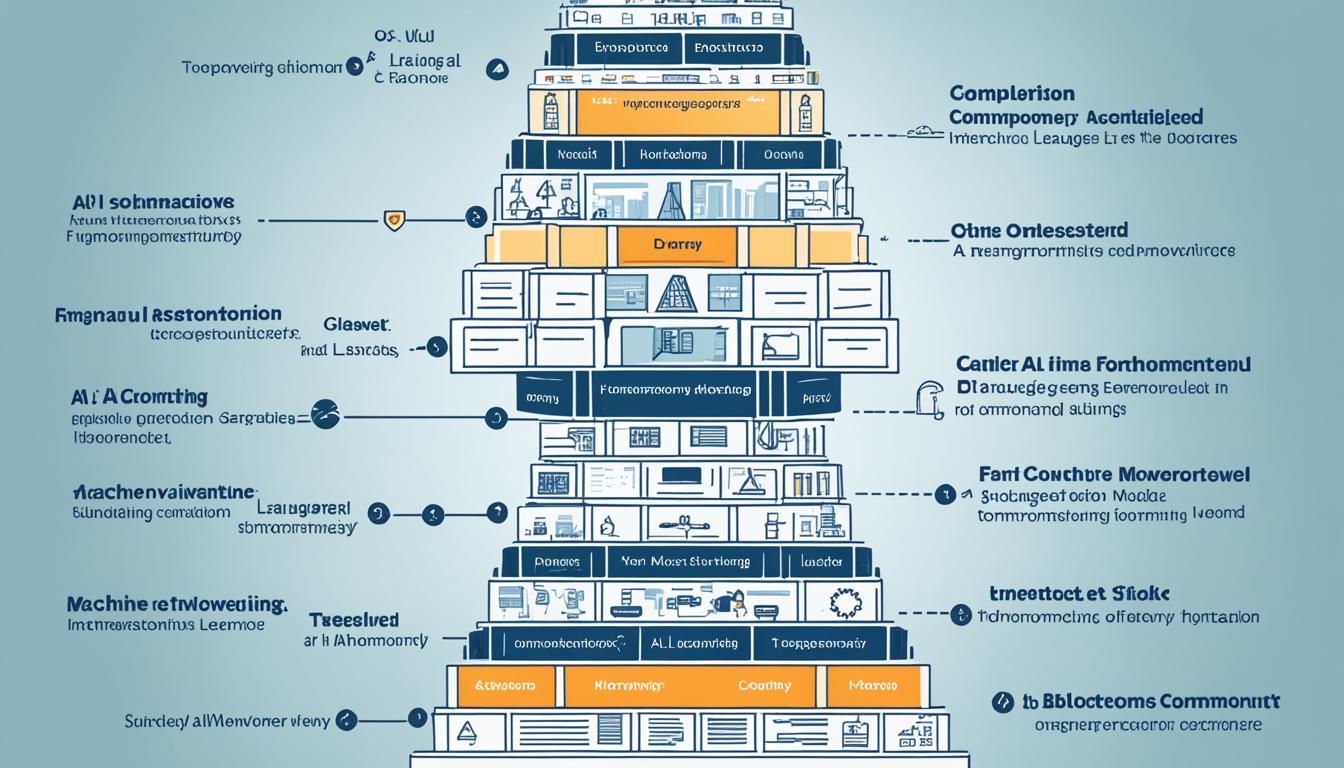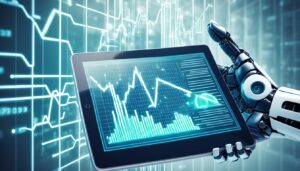
As an AI enthusiast, I am constantly fascinated by the groundbreaking innovations that emerge from the world of artificial intelligence. But have you ever wondered what lies behind these incredible advancements? It all starts with the AI technology stack, the foundation upon which tomorrow’s innovations are built.
The AI technology stack comprises a combination of components and technologies that work together to power AI systems and applications. It’s like a set of building blocks that enable the creation of cutting-edge solutions in various industries.
At the core of the AI technology stack are machine learning algorithms, which allow AI models to learn from data and make predictions or decisions. These algorithms are the driving force behind AI systems, enabling them to understand and interpret complex information.
But building an AI solution is not just about algorithms. It also requires robust data management tools to organize and prepare the vast amounts of data needed for training and inference. Additionally, a powerful hardware infrastructure is essential for efficient data processing and analysis.
To simplify the development process, developers rely on development frameworks that provide tools and libraries for building and deploying AI models. These frameworks, such as TensorFlow and PyTorch, offer pre-built functions for tasks like model training and evaluation.
By understanding the different layers of the AI technology stack, businesses and developers can leverage its capabilities to create innovative solutions that drive progress in various fields. From healthcare to autonomous systems, AI is transforming industries and improving lives.
Key Takeaways:
- The AI technology stack is the foundation of groundbreaking AI innovations.
- It includes machine learning algorithms, data management tools, hardware infrastructure, and development frameworks.
- Machine learning algorithms enable AI systems to learn from data and make predictions or decisions.
- Data management tools help organize and prepare data for AI applications.
- Hardware infrastructure is crucial for efficient data processing and analysis.
Components of the AI Technology Stack
In order to develop and deploy AI solutions, the AI technology stack consists of several key components that are essential for success. These components include:
-
Machine Learning Algorithms
At the heart of AI systems are machine learning algorithms. These algorithms enable machine learning models to learn from data and make predictions or decisions. Examples of machine learning algorithms include classification algorithms, regression algorithms, and clustering algorithms.
-
Data Management Tools
AI systems heavily rely on vast amounts of data for training and inference. Data management tools play a crucial role in organizing, storing, and preparing data for AI applications. Some common data management tools include data warehouses, data lakes, and data preprocessing tools.
-
Hardware Infrastructure
Robust hardware infrastructure is vital to efficiently process and analyze data in the AI technology stack. The hardware infrastructure includes components such as CPUs, GPUs, and specialized hardware like Tensor Processing Units (TPUs) that accelerate AI computations.
-
Development Frameworks
Development frameworks provide the necessary tools and libraries to build and deploy AI models. Popular frameworks such as TensorFlow, PyTorch, and scikit-learn offer pre-built functions for tasks like model training, evaluation, and deployment.
To get a better understanding of the relationships between these components, take a look at the table below:
| Component | Description | Examples |
|---|---|---|
| Machine Learning Algorithms | Algorithms that enable machine learning models to learn from data and make predictions or decisions | Classification algorithms, regression algorithms, clustering algorithms |
| Data Management Tools | Tools for organizing, storing, and preparing data for AI applications | Data warehouses, data lakes, data preprocessing tools |
| Hardware Infrastructure | Physical components required to efficiently process and analyze data | CPUs, GPUs, Tensor Processing Units (TPUs) |
| Development Frameworks | Tools and libraries for building and deploying AI models | TensorFlow, PyTorch, scikit-learn |
By leveraging these components effectively, businesses and developers can harness the power of the AI technology stack to create innovative AI solutions that drive progress in diverse industries.
The Future of AI Innovations
The AI technology stack is constantly evolving, driven by advancements in AI research and technology. This evolution is shaping the future of AI innovations and opening up new possibilities across various industries.
One key trend in the future of AI is deep learning. Deep learning, a subset of machine learning, has revolutionized AI by enabling the training of complex neural networks with multiple layers. This has resulted in significant improvements in areas like computer vision, natural language processing, and speech recognition.
Another important development is edge computing. Edge computing involves processing data at the edge of the network, closer to the source, rather than relying on cloud-based approaches. This allows for faster decision-making and reduced latency, making it ideal for AI applications that require real-time responses.
As AI becomes more integrated into critical decision-making processes, the need for transparency and interpretability is gaining traction. Explainable AI techniques aim to provide insights into how AI models arrive at their decisions, ensuring accountability and trustworthiness.
The healthcare industry stands to benefit greatly from AI advancements. AI applications in healthcare range from disease diagnosis and drug discovery to personalized medicine and telemedicine. AI has the potential to transform healthcare delivery and improve patient outcomes.
Furthermore, AI is powering the development of autonomous systems, from self-driving cars to drones. The integration of AI algorithms with sensor technologies enables these systems to perceive and navigate their environments, leading to advancements in transportation, logistics, and other sectors.
FAQ
What is the AI technology stack?
The AI technology stack is the foundation upon which groundbreaking AI innovations are built. It comprises various components and technologies that work together to power AI systems and applications.
What are the key components of the AI technology stack?
The key components of the AI technology stack include machine learning algorithms, data management tools, hardware infrastructure, and development frameworks.
What are machine learning algorithms?
Machine learning algorithms are at the heart of AI systems and enable machine learning models to learn from data and make predictions or decisions. Examples include classification algorithms, regression algorithms, and clustering algorithms.
How do data management tools contribute to the AI technology stack?
Data management tools, such as data warehouses, data lakes, and data preprocessing tools, help in organizing, storing, and preparing data for AI applications.
What is the role of hardware infrastructure in the AI technology stack?
The AI technology stack requires robust hardware infrastructure to efficiently process and analyze data. This includes CPUs, GPUs, and specialized hardware like Tensor Processing Units (TPUs) that accelerate AI computations.
What are development frameworks in the AI technology stack?
Development frameworks provide the necessary tools and libraries to build and deploy AI models. Popular frameworks include TensorFlow, PyTorch, and scikit-learn, which offer pre-built functions for tasks like model training, evaluation, and deployment.
What are some future trends in AI?
Future trends in AI include deep learning, edge computing, explainable AI, AI in healthcare, and AI in autonomous systems.
How does deep learning contribute to AI advancements?
Deep learning, a subset of machine learning, has revolutionized AI by enabling the training of complex neural networks with multiple layers. This has resulted in significant improvements in areas like computer vision, natural language processing, and speech recognition.
What is edge computing and its relevance to AI?
Edge computing involves processing data at the edge of the network, closer to the source, rather than relying on cloud-based approaches. This allows for faster decision-making and reduced latency, making it ideal for AI applications that require real-time responses.
What is explainable AI and why is it important?
Explainable AI techniques aim to provide insights into how AI models arrive at their decisions, ensuring accountability and trustworthiness. As AI becomes more integrated into critical decision-making processes, the need for transparency and interpretability is gaining traction.
How can AI be applied in the healthcare industry?
The healthcare industry stands to benefit greatly from AI advancements, with applications ranging from disease diagnosis and drug discovery to personalized medicine and telemedicine. AI has the potential to transform healthcare delivery and improve patient outcomes.
How is AI powering the development of autonomous systems?
From self-driving cars to drones, AI is powering the development of autonomous systems. The integration of AI algorithms with sensor technologies enables these systems to perceive and navigate their environments, leading to advancements in transportation, logistics, and other sectors.








